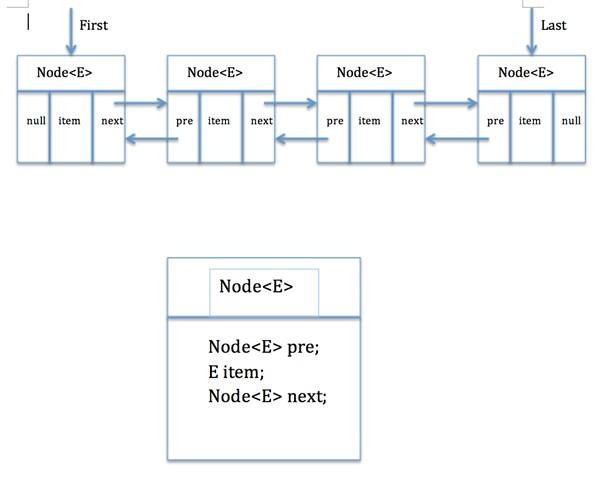简介
LinkedList是一个实现了List接口和Deque接口的双端链表。
public class LinkedList<E>extends AbstractSequentialList<E>implements List<E>, Deque<E>, Cloneable, java.io.Serializable
LinkedList底层的链表结构使它支持高效的插入和删除操作,另外它实现了Deque接口,使得LinkedList类也具有队列的特性;
LinkedList不是线程安全的,如果想使LinkedList变成线程安全的,可以调用静态类Collections类中的synchronizedList方法:
List list=Collections.synchronizedList(new LinkedList(...));
内部结构分析
如下图所示:
看完了图之后,我们再看LinkedList类中的一个内部私有类Node就很好理解了:
private static class Node<E> {E item;//节点值Node<E> next;//后继节点Node<E> prev;//前驱节点Node(Node<E> prev, E element, Node<E> next) {this.item = element;this.next = next;this.prev = prev;}}
这个类就代表双端链表的节点Node。这个类有三个属性,分别是前驱节点,本节点的值,后继结点。
LinkedList源码分析
构造方法
空构造方法:
public LinkedList() {}
用已有的集合创建链表的构造方法:
public LinkedList(Collection<? extends E> c) {this();addAll(c);}
add方法
add(E e) 方法:将元素添加到链表尾部
public boolean add(E e) {linkLast(e);//这里就只调用了这一个方法return true;}
/*** 链接使e作为最后一个元素。*/void linkLast(E e) {final Node<E> l = last;final Node<E> newNode = new Node<>(l, e, null);last = newNode;//新建节点if (l == null)first = newNode;elsel.next = newNode;//指向后继元素也就是指向下一个元素size++;modCount++;}
add(int index,E e):在指定位置添加元素
public void add(int index, E element) {checkPositionIndex(index); //检查索引是否处于[0-size]之间if (index == size)//添加在链表尾部linkLast(element);else//添加在链表中间linkBefore(element, node(index));}
linkBefore方法需要给定两个参数,一个插入节点的值,一个指定的node,所以我们又调用了Node(index)去找到index对应的node
addAll(Collection c ):将集合插入到链表尾部
public boolean addAll(Collection<? extends E> c) {return addAll(size, c);}
addAll(int index, Collection c): 将集合从指定位置开始插入
public boolean addAll(int index, Collection<? extends E> c) {//1:检查index范围是否在size之内checkPositionIndex(index);//2:toArray()方法把集合的数据存到对象数组中Object[] a = c.toArray();int numNew = a.length;if (numNew == 0)return false;//3:得到插入位置的前驱节点和后继节点Node<E> pred, succ;//如果插入位置为尾部,前驱节点为last,后继节点为nullif (index == size) {succ = null;pred = last;}//否则,调用node()方法得到后继节点,再得到前驱节点else {succ = node(index);pred = succ.prev;}// 4:遍历数据将数据插入for (Object o : a) {@SuppressWarnings("unchecked") E e = (E) o;//创建新节点Node<E> newNode = new Node<>(pred, e, null);//如果插入位置在链表头部if (pred == null)first = newNode;elsepred.next = newNode;pred = newNode;}//如果插入位置在尾部,重置last节点if (succ == null) {last = pred;}//否则,将插入的链表与先前链表连接起来else {pred.next = succ;succ.prev = pred;}size += numNew;modCount++;return true;}
上面可以看出addAll方法通常包括下面四个步骤:
- 检查index范围是否在size之内
- toArray()方法把集合的数据存到对象数组中
- 得到插入位置的前驱和后继节点
- 遍历数据,将数据插入到指定位置
addFirst(E e): 将元素添加到链表头部
public void addFirst(E e) {linkFirst(e);}
private void linkFirst(E e) {final Node<E> f = first;final Node<E> newNode = new Node<>(null, e, f);//新建节点,以头节点为后继节点first = newNode;//如果链表为空,last节点也指向该节点if (f == null)last = newNode;//否则,将头节点的前驱指针指向新节点,也就是指向前一个元素elsef.prev = newNode;size++;modCount++;}
addLast(E e): 将元素添加到链表尾部,与 add(E e) 方法一样
public void addLast(E e) {linkLast(e);}
public boolean offer(E e) {return add(e);}public boolean offerFirst(E e) {addFirst(e);return true;}public boolean offerLast(E e) {addLast(e);return true;}
根据位置取数据的方法
get(int index): 根据指定索引返回数据
public E get(int index) {//检查index范围是否在size之内checkElementIndex(index);//调用Node(index)去找到index对应的node然后返回它的值return node(index).item;}
获取头节点(index=0)数据方法:
public E getFirst() {final Node<E> f = first;if (f == null)throw new NoSuchElementException();return f.item;}public E element() {return getFirst();}public E peek() {final Node<E> f = first;return (f == null) ? null : f.item;}public E peekFirst() {final Node<E> f = first;return (f == null) ? null : f.item;}
区别:
getFirst(),element(),peek(),peekFirst()
这四个获取头结点方法的区别在于对链表为空时的处理,是抛出异常还是返回null,其中getFirst() 和element() 方法将会在链表为空时,抛出异常
element()方法的内部就是使用getFirst()实现的。它们会在链表为空时,抛出NoSuchElementException
获取尾节点(index=-1)数据方法:
public E getLast() {final Node<E> l = last;if (l == null)throw new NoSuchElementException();return l.item;}public E peekLast() {final Node<E> l = last;return (l == null) ? null : l.item;}
两者区别:
getLast() 方法在链表为空时,会抛出NoSuchElementException,而peekLast() 则不会,只是会返回 null。
根据对象得到索引的方法
int indexOf(Object o): 从头遍历找
public int indexOf(Object o) {int index = 0;if (o == null) {//从头遍历for (Node<E> x = first; x != null; x = x.next) {if (x.item == null)return index;index++;}} else {//从头遍历for (Node<E> x = first; x != null; x = x.next) {if (o.equals(x.item))return index;index++;}}return -1;}
int lastIndexOf(Object o): 从尾遍历找
public int lastIndexOf(Object o) {int index = size;if (o == null) {//从尾遍历for (Node<E> x = last; x != null; x = x.prev) {index--;if (x.item == null)return index;}} else {//从尾遍历for (Node<E> x = last; x != null; x = x.prev) {index--;if (o.equals(x.item))return index;}}return -1;}
检查链表是否包含某对象的方法:
contains(Object o): 检查对象o是否存在于链表中
public boolean contains(Object o) {return indexOf(o) != -1;}
删除方法
remove() ,removeFirst(),pop(): 删除头节点
public E pop() {return removeFirst();}public E remove() {return removeFirst();}public E removeFirst() {final Node<E> f = first;if (f == null)throw new NoSuchElementException();return unlinkFirst(f);}
removeLast(),pollLast(): 删除尾节点
public E removeLast() {final Node<E> l = last;if (l == null)throw new NoSuchElementException();return unlinkLast(l);}public E pollLast() {final Node<E> l = last;return (l == null) ? null : unlinkLast(l);}
区别: removeLast()在链表为空时将抛出NoSuchElementException,而pollLast()方法返回null。
remove(Object o): 删除指定元素
public boolean remove(Object o) {//如果删除对象为nullif (o == null) {//从头开始遍历for (Node<E> x = first; x != null; x = x.next) {//找到元素if (x.item == null) {//从链表中移除找到的元素unlink(x);return true;}}} else {//从头开始遍历for (Node<E> x = first; x != null; x = x.next) {//找到元素if (o.equals(x.item)) {//从链表中移除找到的元素unlink(x);return true;}}}return false;}
当删除指定对象时,只需调用remove(Object o)即可,不过该方法一次只会删除一个匹配的对象,如果删除了匹配对象,返回true,否则false。
unlink(Node x) 方法:
E unlink(Node<E> x) {// assert x != null;final E element = x.item;final Node<E> next = x.next;//得到后继节点final Node<E> prev = x.prev;//得到前驱节点//删除前驱指针if (prev == null) {first = next;//如果删除的节点是头节点,令头节点指向该节点的后继节点} else {prev.next = next;//将前驱节点的后继节点指向后继节点x.prev = null;}//删除后继指针if (next == null) {last = prev;//如果删除的节点是尾节点,令尾节点指向该节点的前驱节点} else {next.prev = prev;x.next = null;}x.item = null;size--;modCount++;return element;}
remove(int index):删除指定位置的元素
public E remove(int index) {//检查index范围checkElementIndex(index);//将节点删除return unlink(node(index));}
LinkedList类常用方法测试
package list;import java.util.Iterator;import java.util.LinkedList;public class LinkedListDemo {public static void main(String[] srgs) {//创建存放int类型的linkedListLinkedList<Integer> linkedList = new LinkedList<>();/************************** linkedList的基本操作 ************************/linkedList.addFirst(0); // 添加元素到列表开头linkedList.add(1); // 在列表结尾添加元素linkedList.add(2, 2); // 在指定位置添加元素linkedList.addLast(3); // 添加元素到列表结尾System.out.println("LinkedList(直接输出的): " + linkedList);System.out.println("getFirst()获得第一个元素: " + linkedList.getFirst()); // 返回此列表的第一个元素System.out.println("getLast()获得第最后一个元素: " + linkedList.getLast()); // 返回此列表的最后一个元素System.out.println("removeFirst()删除第一个元素并返回: " + linkedList.removeFirst()); // 移除并返回此列表的第一个元素System.out.println("removeLast()删除最后一个元素并返回: " + linkedList.removeLast()); // 移除并返回此列表的最后一个元素System.out.println("After remove:" + linkedList);System.out.println("contains()方法判断列表是否包含1这个元素:" + linkedList.contains(1)); // 判断此列表包含指定元素,如果是,则返回trueSystem.out.println("该linkedList的大小 : " + linkedList.size()); // 返回此列表的元素个数/************************** 位置访问操作 ************************/System.out.println("-----------------------------------------");linkedList.set(1, 3); // 将此列表中指定位置的元素替换为指定的元素System.out.println("After set(1, 3):" + linkedList);System.out.println("get(1)获得指定位置(这里为1)的元素: " + linkedList.get(1)); // 返回此列表中指定位置处的元素/************************** Search操作 ************************/System.out.println("-----------------------------------------");linkedList.add(3);System.out.println("indexOf(3): " + linkedList.indexOf(3)); // 返回此列表中首次出现的指定元素的索引System.out.println("lastIndexOf(3): " + linkedList.lastIndexOf(3));// 返回此列表中最后出现的指定元素的索引/************************** Queue操作 ************************/System.out.println("-----------------------------------------");System.out.println("peek(): " + linkedList.peek()); // 获取但不移除此列表的头System.out.println("element(): " + linkedList.element()); // 获取但不移除此列表的头linkedList.poll(); // 获取并移除此列表的头System.out.println("After poll():" + linkedList);linkedList.remove();System.out.println("After remove():" + linkedList); // 获取并移除此列表的头linkedList.offer(4);System.out.println("After offer(4):" + linkedList); // 将指定元素添加到此列表的末尾/************************** Deque操作 ************************/System.out.println("-----------------------------------------");linkedList.offerFirst(2); // 在此列表的开头插入指定的元素System.out.println("After offerFirst(2):" + linkedList);linkedList.offerLast(5); // 在此列表末尾插入指定的元素System.out.println("After offerLast(5):" + linkedList);System.out.println("peekFirst(): " + linkedList.peekFirst()); // 获取但不移除此列表的第一个元素System.out.println("peekLast(): " + linkedList.peekLast()); // 获取但不移除此列表的第一个元素linkedList.pollFirst(); // 获取并移除此列表的第一个元素System.out.println("After pollFirst():" + linkedList);linkedList.pollLast(); // 获取并移除此列表的最后一个元素System.out.println("After pollLast():" + linkedList);linkedList.push(2); // 将元素推入此列表所表示的堆栈(插入到列表的头)System.out.println("After push(2):" + linkedList);linkedList.pop(); // 从此列表所表示的堆栈处弹出一个元素(获取并移除列表第一个元素)System.out.println("After pop():" + linkedList);linkedList.add(3);linkedList.removeFirstOccurrence(3); // 从此列表中移除第一次出现的指定元素(从头部到尾部遍历列表)System.out.println("After removeFirstOccurrence(3):" + linkedList);linkedList.removeLastOccurrence(3); // 从此列表中移除最后一次出现的指定元素(从尾部到头部遍历列表)System.out.println("After removeFirstOccurrence(3):" + linkedList);/************************** 遍历操作 ************************/System.out.println("-----------------------------------------");linkedList.clear();for (int i = 0; i < 100000; i++) {linkedList.add(i);}// 迭代器遍历long start = System.currentTimeMillis();Iterator<Integer> iterator = linkedList.iterator();while (iterator.hasNext()) {iterator.next();}long end = System.currentTimeMillis();System.out.println("Iterator:" + (end - start) + " ms");// 顺序遍历(随机遍历)start = System.currentTimeMillis();for (int i = 0; i < linkedList.size(); i++) {linkedList.get(i);}end = System.currentTimeMillis();System.out.println("for:" + (end - start) + " ms");// 另一种for循环遍历start = System.currentTimeMillis();for (Integer i : linkedList);end = System.currentTimeMillis();System.out.println("for2:" + (end - start) + " ms");// 通过pollFirst()或pollLast()来遍历LinkedListLinkedList<Integer> temp1 = new LinkedList<>();temp1.addAll(linkedList);start = System.currentTimeMillis();while (temp1.size() != 0) {temp1.pollFirst();}end = System.currentTimeMillis();System.out.println("pollFirst()或pollLast():" + (end - start) + " ms");// 通过removeFirst()或removeLast()来遍历LinkedListLinkedList<Integer> temp2 = new LinkedList<>();temp2.addAll(linkedList);start = System.currentTimeMillis();while (temp2.size() != 0) {temp2.removeFirst();}end = System.currentTimeMillis();System.out.println("removeFirst()或removeLast():" + (end - start) + " ms");}}

